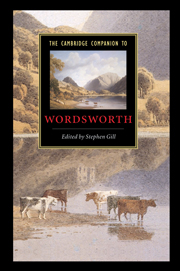Book contents
- Frontmatter
- Introduction
- 1 Wordsworth: the shape of the poetic career
- 2 Wordsworth's poetry to 1798
- 3 Poetry 1798-1807
- 4 'The noble living and the noble dead'
- 5 Wordsworth and The Recluse
- 6 Wordsworth and the meaning of taste
- 7 Wordsworth's craft
- 8 Gender and domesticity
- 9 The philosophic poet
- 10 Wordsworth and Coleridge
- 11 Wordsworth and the natural world
- 12 Politics, history, and Wordsworth's poems
- 13 Wordsworth and Romanticism
- 14 Wordsworth and America
- 15 Textual issues and a guide to further reading
- Index
- Series List
3 - Poetry 1798-1807
Lyrical Ballads and Poems, in Two Volumes
Published online by Cambridge University Press: 28 May 2006
- Frontmatter
- Introduction
- 1 Wordsworth: the shape of the poetic career
- 2 Wordsworth's poetry to 1798
- 3 Poetry 1798-1807
- 4 'The noble living and the noble dead'
- 5 Wordsworth and The Recluse
- 6 Wordsworth and the meaning of taste
- 7 Wordsworth's craft
- 8 Gender and domesticity
- 9 The philosophic poet
- 10 Wordsworth and Coleridge
- 11 Wordsworth and the natural world
- 12 Politics, history, and Wordsworth's poems
- 13 Wordsworth and Romanticism
- 14 Wordsworth and America
- 15 Textual issues and a guide to further reading
- Index
- Series List
Summary
'Wordsworth's name is nothing - to a large number of persons mine stinks', wrote Samuel Taylor Coleridge in 1798, urging publisher Joseph Cottle to issue the poets' co-authored Lyrical Ballads anonymously (STCL i 412). In the ensuing decade,Wordsworth, the man with the 'nothing name', wrote many of the poems that for later generations established him as the principal poet of his age. The change is from seeing Lyrical Ballads as Coleridge's wife Sara early on described it - 'laughed at and disliked by all with very few excepted' - to what is the current critical consensus: 'Historically considered, it remains the most important volume of verse in English since the Renaissance, for it began modern poetry, the poetry of the growing inner self.' Wordsworth's achievement is all the more remarkable because most of the chief poems published in Lyrical Ballads (1798 and 1800) and Poems, in Two Volumes (1807) came from a very few bursts of activity, first at Alfoxden in Somerset, then at Goslar in Germany, and eventually at Grasmere.
Lyrical Ballads (1798)
In the aging memories of the one-time collaborators on Lyrical Ballads, the 1798 volume had a straightforward division of labour. Coleridge in Biographia Literaria (1817) recalled that he was to write on ‘persons and characters supernatural’, while Wordsworth would concentrate on subjects from ‘ordinary life’, giving ‘the charm of novelty to things of every day’ and showing ‘the loveliness and the wonders of the world before us . . .’ (BL ii 5–8). The seventy-three-year-old Wordsworth, in a note dictated to Isabella Fenwick about ‘We Are Seven’, agreed that his task was to write about subjects from common life but to treat them imaginatively. However, Wordsworth’s brief critical statement, or ‘Advertisement’, included in Lyrical Ballads (1798) emphasizes stylistic matters: the majority of the poems were ‘experiments’ written ‘to ascertain how far the language of conversation in the middle and lower classes of society is adapted to the purposes of poetic pleasure’.
- Type
- Chapter
- Information
- The Cambridge Companion to Wordsworth , pp. 38 - 54Publisher: Cambridge University PressPrint publication year: 2003
- 2
- Cited by



